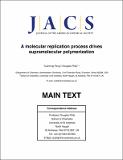A molecular replication process drives supramolecular polymerization
Abstract
Supramolecular polymers are materials in which the connections between monomers in the polymer main chain are non-covalent bonds. This area has seen rapid expansion in the last two decades and has been exploited in several applications. However, suitable contiguous hydrogen bond arrays can be difficult to synthesize, placing some limitations on the deployment of supramolecular polymers. We have designed a hydrogen bonded polymer assembled from a bifunctional monomer composed of two replicating templates separated by a rigid spacer. This design allows the autocatalytic formation of the polymer main chain through the self-templating properties of the replicators and drives the synthesis of the bifunctional monomer from its constituent components in solution. The template-directed 1,3-dipolar cycloaddition reaction between nitrone and maleimide proceeds with high diastereoselectivity affording the bifunctional monomer. The high binding affinity between the self-complementary replicating templates that allow the bifunctional monomer to polymerize in solution is derived from the positive cooperativity associated with this binding process. The assembly of the polymer in solution has been investigated by DOSY NMR spectroscopy. Both microcrystalline and thin films of the polymeric material can be prepared readily and have been characterized by powder X-ray diffraction and scanning electron microscopy. These results demonstrate that the approach described here is a valid one for the construction of supramolecular polymers and can be extended to systems where the rigid spacer between the replicating templates is replaced by one carrying additional function.
Citation
Feng , Y & Philp , D 2021 , ' A molecular replication process drives supramolecular polymerization ' , Journal of the American Chemical Society , vol. Articles ASAP . https://doi.org/10.1021/jacs.1c06404
Publication
Journal of the American Chemical Society
Status
Peer reviewed
ISSN
0002-7863Type
Journal article
Description
This research made use of the IMSERC NMR, MS and PXRD facility at Northwestern University, which has received support from the Soft and Hybrid Nanotechnology Experimental (SHyNE) Resource (NSF ECCS-2025633) and Northwestern University. This research made use of the EPIC SEM facility of Northwestern University’s NUANCE Center, which has received support from the SHyNE Resource (NSF ECCS-2025633), the IIN, and Northwestern's MRSEC program (NSF DMR-1720139).Collections
Items in the St Andrews Research Repository are protected by copyright, with all rights reserved, unless otherwise indicated.

